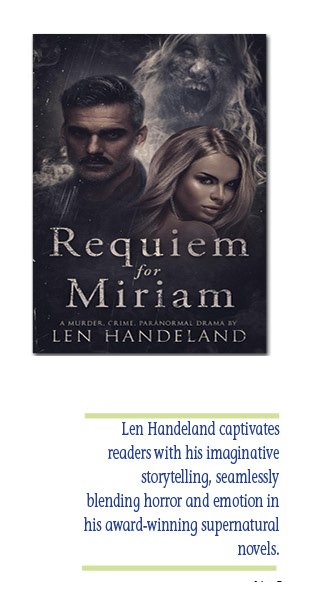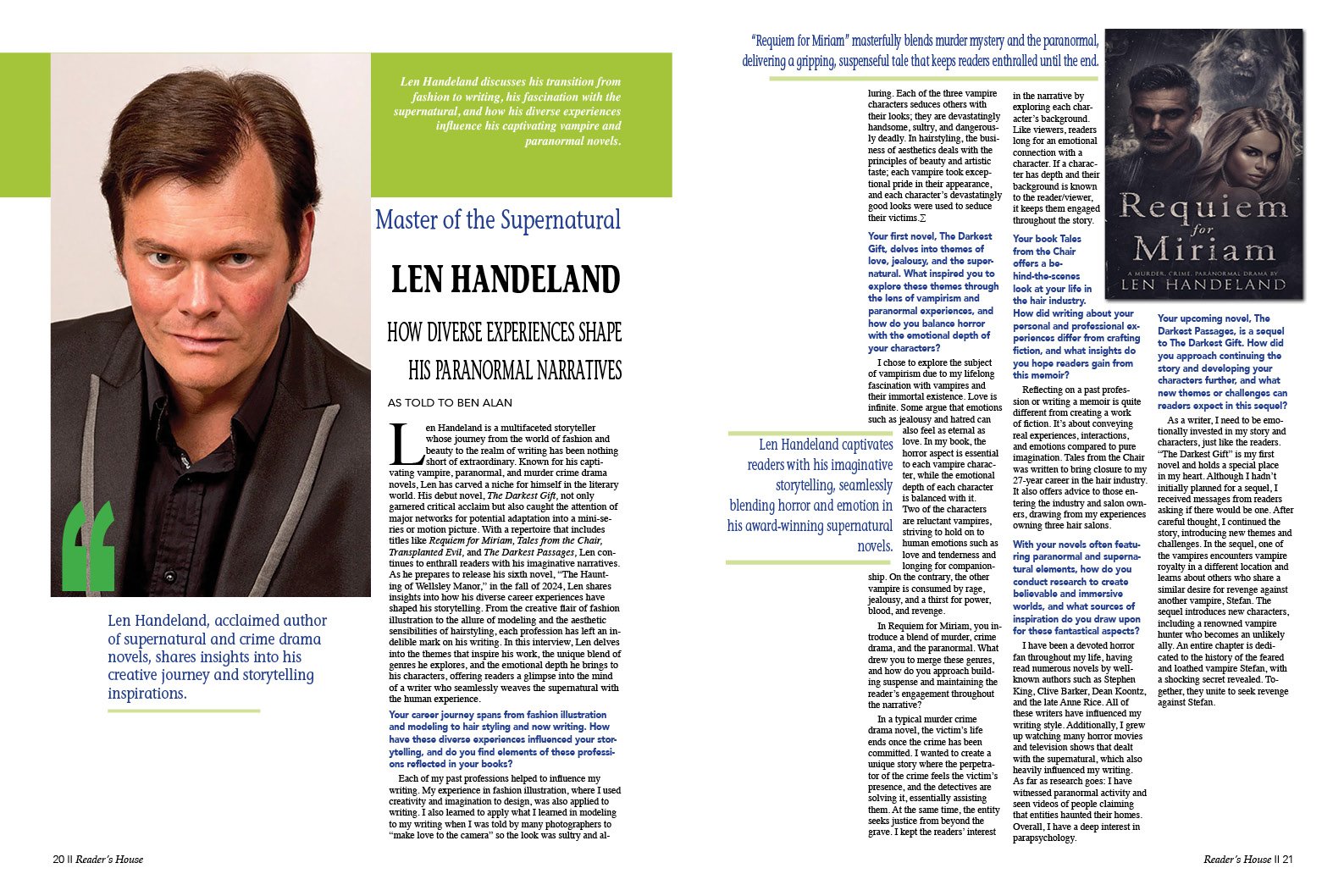How Diverse Experiences Shape His Paranormal Narratives
Len Handeland discusses his transition from fashion to writing, his fascination with the supernatural, and how his diverse experiences influence his captivating vampire and paranormal novels.
Len Handeland is a multifaceted storyteller whose journey from the world of fashion and beauty to the realm of writing has been nothing short of extraordinary. Known for his captivating vampire, paranormal, and murder crime drama novels, Len has carved a niche for himself in the literary world. His debut novel, “The Darkest Gift,” not only garnered critical acclaim but also caught the attention of major networks for potential adaptation into a mini-series or motion picture. With a repertoire that includes titles like Requiem for Miriam, Tales from the Chair, Transplanted Evil, and The Darkest Passages, Len continues to enthrall readers with his imaginative narratives. As he prepares to release his sixth novel, “The Haunting of Wellsley Manor,” in the fall of 2024, Len shares insights into how his diverse career experiences have shaped his storytelling. From the creative flair of fashion illustration to the allure of modeling and the aesthetic sensibilities of hairstyling, each profession has left an indelible mark on his writing. In this interview, Len delves into the themes that inspire his work, the unique blend of genres he explores, and the emotional depth he brings to his characters, offering readers a glimpse into the mind of a writer who seamlessly weaves the supernatural with the human experience.
Your career journey spans from fashion illustration and modeling to hair styling and now writing. How have these diverse experiences influenced your storytelling, and do you find elements of these professions reflected in your books?
Each of my past professions helped to influence my writing. My experience in fashion illustration, where I used creativity and imagination to design, was also applied to writing. I also learned to apply what I learned in modeling to my writing when I was told by many photographers to “make love to the camera” so the look was sultry and alluring. Each of the three vampire characters seduces others with their looks; they are devastatingly handsome, sultry, and dangerously deadly. In hairstyling, the business of aesthetics deals with the principles of beauty and artistic taste; each vampire took exceptional pride in their appearance, and each character’s devastatingly good looks were used to seduce their victims.

Your first novel, The Darkest Gift, delves into themes of love, jealousy, and the supernatural. What inspired you to explore these themes through the lens of vampirism and paranormal experiences, and how do you balance horror with the emotional depth of your characters?
I chose to explore the subject of vampirism due to my lifelong fascination with vampires and their immortal existence. Love is infinite. Some argue that emotions such as jealousy and hatred can also feel as eternal as love. In my book, the horror aspect is essential to each vampire character, while the emotional depth of each character is balanced with it. Two of the characters are reluctant vampires, striving to hold on to human emotions such as love and tenderness and longing for companionship. On the contrary, the other vampire is consumed by rage, jealousy, and a thirst for power, blood, and revenge.
In Requiem for Miriam, you introduce a blend of murder, crime drama, and the paranormal. What drew you to merge these genres, and how do you approach building suspense and maintaining the reader’s engagement throughout the narrative?
In a typical murder crime drama novel, the victim’s life ends once the crime has been committed. I wanted to create a unique story where the perpetrator of the crime feels the victim’s presence, and the detectives are solving it, essentially assisting them. At the same time, the entity seeks justice from beyond the grave. I kept the readers’ interest in the narrative by exploring each character’s background. Like viewers, readers long for an emotional connection with a character. If a character has depth and their background is known to the reader/viewer, it keeps them engaged throughout the story.
Your book Tales from the Chair offers a behind-the-scenes look at your life in the hair industry. How did writing about your personal and professional experiences differ from crafting fiction, and what insights do you hope readers gain from this memoir?
Reflecting on a past profession or writing a memoir is quite different from creating a work of fiction. It’s about conveying real experiences, interactions, and emotions compared to pure imagination. Tales from the Chair was written to bring closure to my 27-year career in the hair industry. It also offers advice to those entering the industry and salon owners, drawing from my experiences owning three hair salons.
With your novels often featuring paranormal and supernatural elements, how do you conduct research to create believable and immersive worlds, and what sources of inspiration do you draw upon for these fantastical aspects?
I have been a devoted horror fan throughout my life, having read numerous novels by well-known authors such as Stephen King, Clive Barker, Dean Koontz, and the late Anne Rice. All of these writers have influenced my writing style. Additionally, I grew up watching many horror movies and television shows that dealt with the supernatural, which also heavily influenced my writing. As far as research goes: I have witnessed paranormal activity and seen videos of people claiming that entities haunted their homes. Overall, I have a deep interest in parapsychology.
Your upcoming novel, The Darkest Passages, is a sequel to The Darkest Gift. How did you approach continuing the story and developing your characters further, and what new themes or challenges can readers expect in this sequel?
As a writer, I need to be emotionally invested in my story and characters, just like the readers. “The Darkest Gift” is my first novel and holds a special place in my heart. Although I hadn’t initially planned for a sequel, I received messages from readers asking if there would be one. After careful thought, I continued the story, introducing new themes and challenges. In the sequel, one of the vampires encounters vampire royalty in a different location and learns about others who share a similar desire for revenge against another vampire, Stefan. The sequel introduces new characters, including a renowned vampire hunter who becomes an unlikely ally. An entire chapter is dedicated to the history of the feared and loathed vampire Stefan, with a shocking secret revealed. Together, they unite to seek revenge against Stefan.



